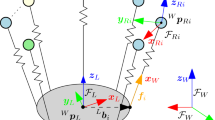Abstract
A decentralized control approach is presented for a network of robotic sensors to achieve the global coordination: group aggregation or consensus flocking. Each robotic sensor obeys three local interaction rules: group cohesion, collision avoidance and velocity alignment. Accordingly, the resultant control law for each robotic sensor is composed of three associated control components. The cohesion control component is based on geometry and additionally enables maintaining initial interconnection of network. The alignment control component ensures that all members in an interconnected network eventually reach to a common velocity. The control component for collision avoidance among members, as a passive role, is embedded in cohesion control. Simulation results demonstrate the capability of the proposed control approach in achieving the coordination behaviour with an initially interconnected network. However, we observed that an initially non-interconnected network may also achieve the coordination behaviour depending on the initial distribution and velocities. Initial interconnection of a network is only a sufficient but not essential condition for the network to achieve the coordination behaviour for our control approach.








Similar content being viewed by others
References
Lopez, U., Gautrais, J., Couzin, I. D., et al. (2012). From behavioural analyses to models of collective motion in fish schools. Interface Focus, 2(6), 693–707.
Reynolds, C. W. (1987). Flocks, herds and schools: A distributed behavioral model. Computer Graphics, 21(4), 25–34.
Williams, R. K., & Sukhatme, G. S. (2013). Constrained interaction and coordination in proximity-limited multiagent systems. IEEE Transactions on Robotics, 29(4), 930–944.
Li, X., & Chen, H. (2014). An interactive control algorithm used for equilateral triangle formation with robotic sensors. Sensors, 14(4), 7229–7247.
Rezaee, H., & Abdollahi, F. (2014). A decentralized cooperative control scheme with obstacle avoidance for a team of mobile robots. IEEE Transactions on Industrial Electronics, 61(1), 347–354.
Dimarogonas, D. V. (2012). Sufficient conditions for decentralized potential functions based controllers using canonical vector fields. IEEE Transactions on Automatic Control, 57(10), 2621–2626.
Brutschy, A., Garattoni, L., Brambilla, M., et al. (2015). The TAM: Abstracting complex tasks in swarm robotics research. Swarm Intelligence, 9(1), 1–22.
Casteigts, A., Albert, J., Chaumette, S., et al. (2012). Biconnecting a network of mobile robots using virtual angular forces. Computer Communications, 35, 1038–1046.
Tanner, H. G., Jadbabaie, A., & Pappas, G. J. (2007). Flocking in fixed and switching networks. IEEE Transactions on Automatic Control, 52(5), 863–868.
Kim, D. H., Wang, H., & Shin, S. (2006). Decentralized control of autonomous swarm systems using artificial potential function: Analytical design guidelines. Journal of Intelligent and Robotic Systems, 45(4), 369–394.
Balch, T., & Arkin, R. C. (1998). Behavior-based formation control for multi-robot teams. IEEE Transactions on Robotics and Automation, 14(6), 926–939.
Spears, W. M., Spears, D. F., Hamann, J. C., et al. (2004). Distributed, physics-based control of swarms of vehicles. Autonomous Robots, 17(2–3), 137–162.
Spears, D., Kerr, W., & Spears, W. (2006). Physics-based robot swarms for coverage problems. International Journal of Intelligent Control and Systems, 11(3), 11–23.
Derr, K., & Manic, M. (2011). Extended virtual spring mesh (evsm): The distributed self-organizing mobile ad hoc network for area exploration. IEEE Transactions on Industrial Electronics, 58(12), 5424–5437.
Derr, K., & Manic, M. (2013). Adaptive control parameters for dispersal of multi-agent mobile ad hoc network (manet) swarms. IEEE Transactions on Industrial Informatics, 9(4), 1900–1911.
Ercan, M. F., & Li, X. (2011). Swarm robot flocking: an empirical study research. Lecture notes in artificial intelligence (Vol. 7102, pp. 495–504).
Li, X., & Ercan, M. F. (2016). An algorithm for smallest enclosing circle problem of planar point sets. Lecture notes in computer science (Vol. 9786, pp. 309–318).
Feng, H., Endrias, D. H., & Taher, M. A. (2013). An accurate and efficient algorithm for determining minimum circumscribed circles and spheres from discrete data points. Computer-Aided Design, 45, 105–112.
Chaumont, N., & Adami, C. (2016). Evolution of sustained foraging in three-dimensional environments with physics. Genetic Programming and Evolvable Machines, 17(4), 359–390.
Acknowledgements
The authors acknowledge the Science Research Foundation of Yulin Normal University (Grant: G2017013) and Singapore Tote Board (Grants: 11- 27801-36-M115 and 11-30012-36-M115).
Author information
Authors and Affiliations
Corresponding author
Rights and permissions
About this article
Cite this article
Li, X., Ercan, M.F. Decentralized Coordination Control for a Network of Mobile Robotic Sensors. Wireless Pers Commun 102, 2429–2442 (2018). https://doi.org/10.1007/s11277-018-5263-y
Published:
Issue Date:
DOI: https://doi.org/10.1007/s11277-018-5263-y




